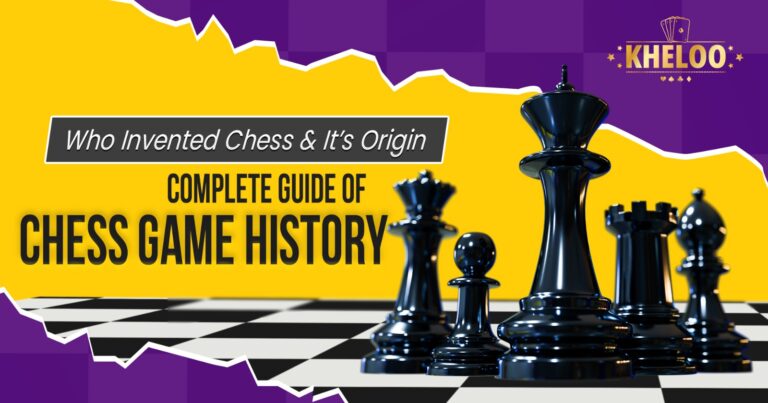Chess is a tricky, super interesting game. People have loved it for, like, forever. Wondering where it came from? Who made it? When did it start? Let’s dive into all that and more, exploring the long, cool history of chess.
The real beginning of chess is like a big mystery. Lots of stories say different things about who made it. Some say an Indian thinker named Sissa ben Dahir made it. Others think it was the ancient Chinese, Greeks, or Persians. Too bad we might never really know who did it, but the story kicks off in ancient India with the Gupta Empire.
We’re gonna go way back, like to the 6th century AD in India. There was this game called “chaturanga,” kind of like a warm-up to modern chess. It had four players and mixed in some cool strategy stuff that we still use in chess today. Over time, it turned into the chess we play now.
As we keep going, chess changes a lot, like a makeover but for games. The chessboard, this space for tricks and strategy, watches it all happen. From chaturanga in ancient India to today’s chess with all its twists, each step makes a new piece of the story.
Chess is like a smart, cool song that people play in different places and times. Smart moves, tricky plans, and super-smooth thinking have been around forever. From India’s royal hangouts to today’s world chess showdowns, it shows how being super clever is timeless.
Even with all the chess history, we still have big questions. Who really came up with chess? When did the first piece hit the chess scene? We might not ever find out, but that’s part of what makes chess so interesting. The hunt for answers keeps the fun alive.
Now, let’s zoom into today. Chess is still here, still kicking. The start might be a mystery, but chess has left its mark big time. Jump into the game, make your moves, and be a part of chess’s story. It’s like a never-ending tale, and you get to be a cool character.
In the game of pieces and sneaky strategies, chess keeps grabbing attention. It’s not just a game; it’s a classic that’s been rocking for ages.
Chess Genesis:
In the intricate tapestry of chess’s beginnings, India takes centre stage. The Gupta Empire, around the 6th century AD, birthed the chess phenomenon. The game of Chaturanga, born in these ancient Indian lands, embarked on a journey beyond borders, weaving its spell far and wide.
Chaturanga’s Journey:
Chaturanga didn’t stay put in India. It ventured beyond, journeying through the vast expanse of the Indian subcontinent. Its whispers reached Persia, where it underwent a metamorphosis, transforming into the Persian rendition known as “shatranj.” The chess narrative began to unfold in new chapters, crossing cultural boundaries.
When the Islamic caliphate conquered Persia in the 7th century, shatranj found new homes and embraced change. Under the influence of diverse cultures, it underwent significant transformations, aligning its steps with the dance of time. This evolution brought it closer to the chess we play today, a game shaped by the fusion of histories and minds.
Also Read: 8 Unique Ways to Win in the Housie Game
From Gupta Empire to Modern Chess: A Historic Evolution
Chess, the brainchild of the Gupta Empire, embarked on a grand expedition. Originating in India, Chaturanga laid the groundwork. Its journey across lands, from Persia to the Islamic world, birthed shatranj. With each move and cultural infusion, the game evolved into the modern chess we cherish today. A saga of strategy, travel, and adaptation, etching its mark on the annals of history.
Decoding the Chess
Traveling through the enigmatic chess saga reveals a captivating ride, where genius isn’t a solo star but a collective brilliance. Chess, the brainchild of Chaturanga in India, tangoed its way through history, encountering the vibrant realms of Persia and the Islamic world, morphing into the intricate symphony of strategy we grapple with today.
As chess turned through the corridors of time, it bumped into the vibrant landscapes of Persia and the Islamic world. This encounter triggered a metamorphosis, a magical dance that shaped the chessboard into the complex strategic ballet we play today.
Imagine a battlefield, not with soldiers and weapons, but with a simple 8×8 checkerboard. Here, two minds engage in an eternal duel – this is chess, a classic duel that spans borders and ages.
At the heart of chess lies a royal quest – capturing the rival’s king with an inescapable threat, the elusive checkmate. Picture it as a strategic ambush, where every move inches us closer to triumph or doom.
Exactly how to Play Chess?
Every chess commander leads a group of 16 pieces, each playing a unique role in the unfolding drama. Kings, queens, rooks, knights, bishops, and pawns join forces, moving across the board with distinct choreography.
The board transforms into a stage, and the pieces engage in a dance dictated by rules and strategies. Mastering this ballet requires foresight, tactical brilliance, and the ability to outmanoeuvre your opponent in the grand chess dance.
Beyond the wooden battleground, chess transforms into a mental joust where players anticipate, strategize, and adapt. The game demands not just skill but also finesse to shield your army while plotting the downfall of your foe.
Also Read: Top 12 Most Entertaining and Fun Games to Play
The Puzzling Birth of Chess
The birth of chess remains wrapped in mystery, a puzzle missing a few crucial pieces. Yet, as the game evolved and journeyed through time, it evolved into an enduring symbol of intellect, strategy, and cultural exchange.
Playing chess isn’t merely a game; it’s a journey through history. From India to Persia and beyond, we participate in a tradition that links us to players across cultures and eons. Each move echoes the steps of those who came before, crafting a timeless symphony of intellect and strategy.
In the chess cosmos, where past and present intertwine, every move isn’t just a play; it’s a contribution to a legacy that echoes through ages.

Dive into FAQs about Chess Birth & Roots
- Who’s the Brain Behind Chess?
So, who cooked up chess? Tough question. No one really knows. But, way back in India, like in the 6th century AD, people played something called chaturanga. That’s like the grandparent of chess. - Indian Chess Story: When & Where?
India’s where chess threw its roots. Gupta Empire times. Chaturanga was the game-changer, paving the way for today’s chess masterpiece. India’s like chess HQ. - The Evolution Tale: Who Turned Old Chess into Cool Chess?
Finding one big boss for modern chess is tricky. It went from Indian Chaturanga to Persian Shatranj, then went wild in the Islamic world, getting a makeover. A team effort, you could say. - Chess Adventure: India to Everywhere
Picture this: India, 6th century AD, chess is born. It travels to Persia, gets a new name, Shatranj. Then, zooms into the Islamic world, picking up more cool stuff. The result? The worldwide chess craze. - Cultural Chess Canvas: India’s Masterpiece
India, Gupta Empire era, chess is a cultural hero. Starting as Chaturanga, it danced into Persia as Shatranj. It’s more than a game; it’s a global strategy superstar.




Comments are closed.